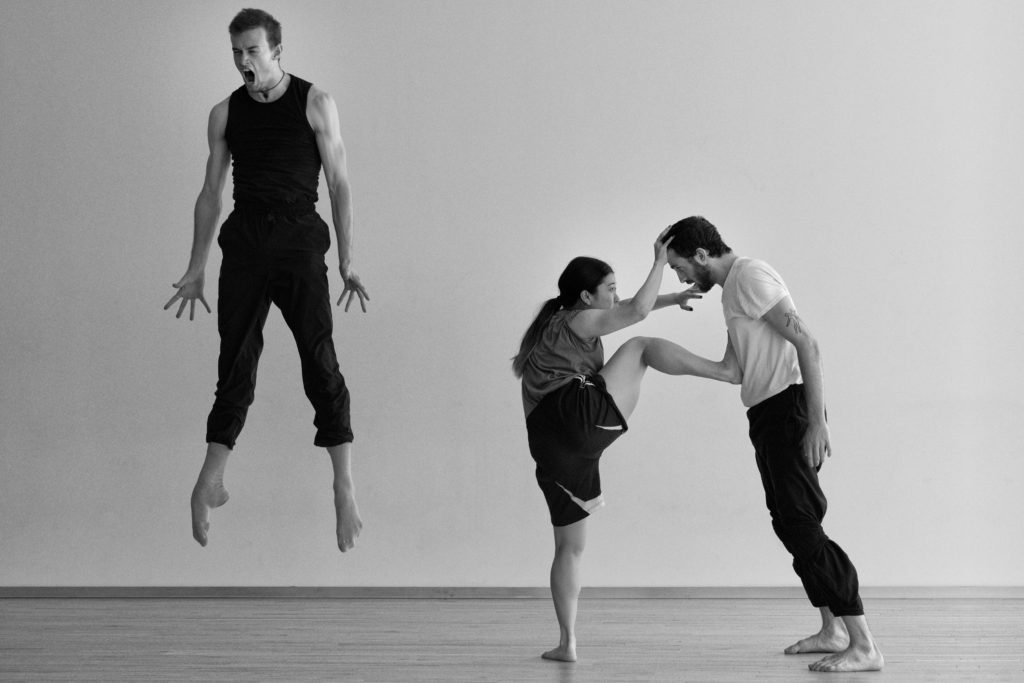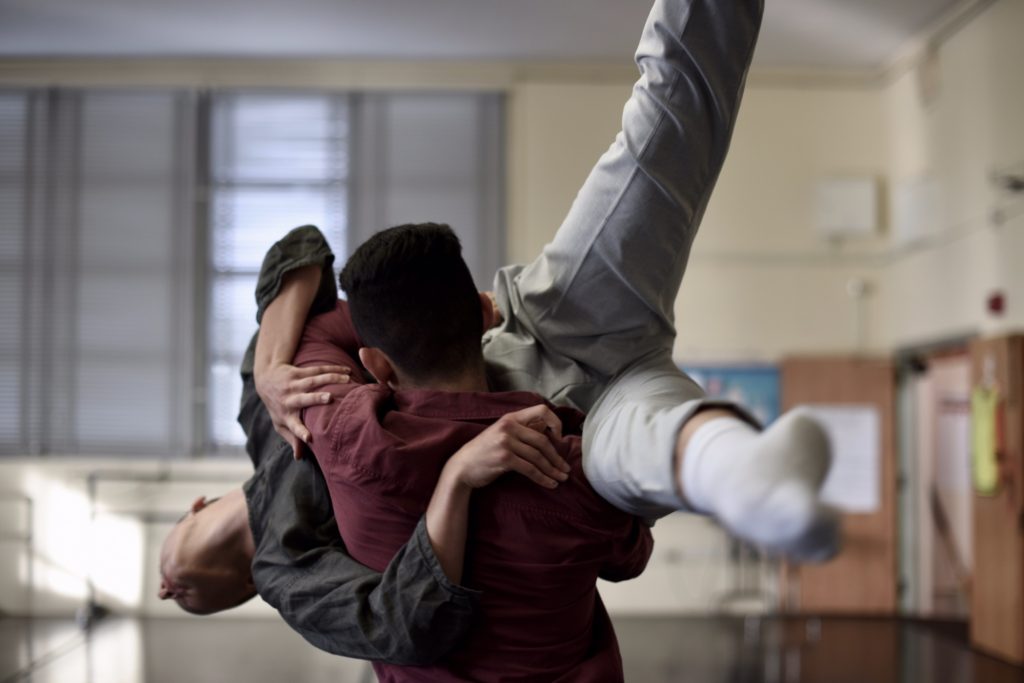Training Program
AlumniALUMNI SPOTLIGHTS
Adrian de Leeuw
Training Program Alumni
Adrian shares how his experience in the LINES Ballet I Training Program has shaped him as an artist, thinker and mover.
The Training Program was very formative for me, in regards to the way I view myself as an artist and presence in the room. Far from being fully-formed as either of those, I feel that I am more in touch with my current situation and more capable of taking control of my situation.
I can’t say that I was expecting any of the events in this program and I certainly wasn’t expecting them to change me in the way that they did. What left the deepest impression on me was the constant attention to the individual, even in something as codified as ballet. Maurya Kerr will always guide me through ballet class wherever I go and whoever I take class with, the rigorous attention to detail was always complemented and put in contrast with the push to test yourself and challenge your abilities.
There are a few memorable sentences that continue to guide me in my work. ‘Don’t just do something, stand there.’ A reminder that filling time and space with movement isn’t always the best choice. Sometimes observing the room and allowing yourself to become attuned to what your peers and the space needs, then following your instincts and beginning to add yourself to the space. ‘Just show up and do the work.’ One of the classic LINES Training Program sayings, it’s a good one and that’s why it has stuck. There’s nothing to do but show up, leave your other thoughts and worries at the door and do what is asked of you. That is how you participate in a working room and choreographic process.
San Francisco is a much larger city than Victoria, so much hustle and bustle. So many people going about their days working on making their lives better, whatever class they belong to, rich or poor. Despite people pursuing their own lives I’ve never felt threatened or treated poorly in SF. My favourite part about the city is the width of the streets, it sounds odd but it really helps this big city feel less oppressive or closed in. It makes being in the city less stressful and makes the general experience more enjoyable.
Creating a work alongside David Harvey changed the way that I viewed choreography and movement. It added another tool to my belt in both movement and choreography. Learning how to operate in another modality, speed, texture and energy was valuable. To sit in it for a few months allowed it to be firmly added to my tool belt.
Don’t be afraid of something that sits outside of your knowledge. Even if you look at this new information and believe that you don’t like it or won’t like it, give it a chance. Allow yourself to hold it and look at it, then decide if you want it. Decide to keep it or throw it away but there is a small chance that a part of it is worth keeping and using. Taking that chance and finding something new could be invaluable.
I am interested in photography, dance-for-film and choreography. Choreography informs the way that I dance. Photography and dance-for-film have informed the way that I see ‘frame’, whether it is in a proscenium, site-specific or in the studio. Photography has also changed the way that I view myself as an artist because my photography study consists of self-portaits and it has helped me situate myself as someone who will be viewed.
Since completing the training program I have attended the Springboard Summer Intensive, performing a piece choreographed by Marco Goeke.
Photography: Training Program I Choreographer Gioconda Barbuto & Dancer Adrian de Leeuw I © Michael Slobodian
Emily Haughton
Training Program Alumni
Hometown: Alexandria, VA
What have you been doing since you completed the Training Program?
I moved to New York city to further pursue my dance career. I am doing a summer intensive with SpringboardX.
How would you describe your overall experience at LINES?
My two years at Lines were probably some of my most transformative years as a dancer. I was encouraged to explore why I dance, I enjoyed pushing myself in classes and workshops, and began to establish a healthy and constructive relationship between myself and dance.
What was your most unexpected yet impressionable moment as a student?
When Alonzo told us we were free. I always had this perception of dance having limitations or restrictions because no one had ever said different, but it was mind- blowing and refreshing to know that dance itself doesn’t have a limitation.
What memorable lesson or feedback has stayed with you since leaving Training Program?
Very simply, show up and do the work. Be present in class.
In what ways did you grow during your two years in the Training Program?
I dance more maturely now because I have a better understanding of how to use my body as a dancer.
What have you learned about working with injuries and obstacles?
You can still participate with an injury. It shouldn’t inhibit you from showing up and putting your best effort forward, but you need to be mindful of your limitations while injured. And there will always be obstacles to anything worth achieving. Identify the obstacles, and then identify the solution.
What advice would you give to current and prospective Training Program students?
This program allows you to process and discover yourself. If you are not present physically and mentally in classes and workshops, you are cheating yourself out of the opportunity to grow as a person and dancer.
Photography: Training Program I Dancer Emily Haughton I Ethereal Pixels I © Ron Rothenberg
Gretchen Ackerman
Training Program Alumni
Hometown: Detroit, Michigan
What have you been doing since you completed the Training Program?
Since completing LINES Ballet Training Program, I have finished my first season with Dark Circles Contemporary Dance and begun work on collaborations with other dancers and visual/music artists.
How would you describe your overall experience at LINES?
A whirlwind of experiences and lessons; exciting, difficult, frightening, and glorious.
How did your understanding of dance change during your time in the program?
My classmates’ movement language expanded my visions of what dance is; our intimate, vulnerable time together allowed for space to see the potential of the future. Once we were out, it was only a matter of committing to those beginning ideas.
What was your most unexpected yet impressionable moment as a student?
Being asked by Karah why I wasn’t taking myself seriously while in my head believing I was too serious about things; lessons in perspective.
What is one of the impactful ideas that you were introduced to in the program?
Bunches of ideas and thoughts from every person I met. One moment with Alonzo I come back to daily though: “it is not the most talented, nor the most hard working, but the one most receptive to change.”
What memorable lesson or feedback has stayed with you since leaving the Training Program?
Leave any and all pre conceptions and assumptions of yourself and most everything around you at the door and never return to them.
How is a conservatory-style program beneficial for aspiring dancers?
Conservatory style training puts one in an environment emphasizing intense training, community, and artistic development- effectively preparing one for the demanding, anything goes, ever evolving art world we live in.
Which creative processes from your time in the Training Program stands out to you as particularly inspiring?
I would like to say all of them. The first ones which come to mind are Maurya’s repertoire classes where we worked relentlessly on a single variation while using different tools to explore dynamics; with Alex Ketley came an absolutely foreign language of movement and method by which to explore it, focus placed on sensation exploration rather than execution. Gioconda Barbuto used improvisational techniques to create insane orchestras of bodies in just a few hours. Every moment in a room with Alonzo- the constant push for more and belief in more is great.
Photography: Training Program I Dancer Gretchen Ackerman I © Joshua L. Peugh & Keivan Orozco
Banner Photography: Alonzo King LINES Ballet I Training Program I © Alabastro Photography



